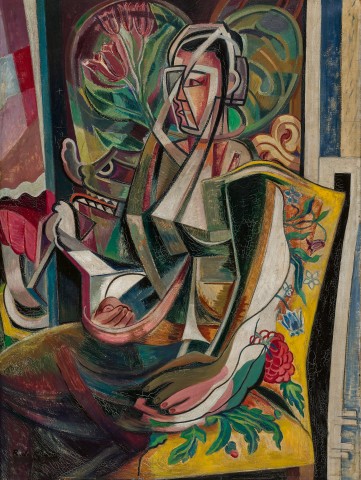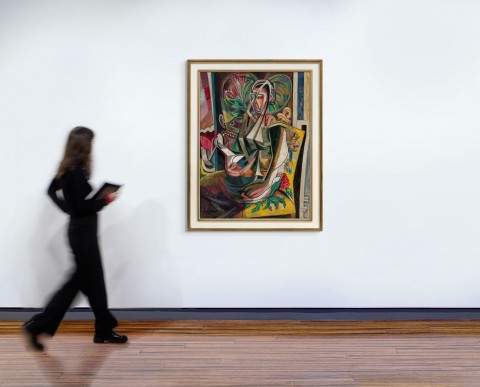(1894 - 1968)
Roy De Maistre
Woman in a chair, c.1944
oil on canvas
Lord Ashbourne (William Gibson), London
Thence by descent
Christina Gibson (later Mrs J. J. Byam Shaw), London, 1960
Art Gallery of South Australia, Adelaide, a gift from the above in 1969
Deutscher~Menzies, Sydney, 15 June 2005, lot 31
Private collection, Melbourne
Roy de Maistre: A Retrospective Exhibition of Paintings and Drawings 1917 – 1960, Whitechapel Art Gallery, London, May – June 1960, cat. 56
Johnson, H., Roy de Maistre: The English Years 1930 – 1968, Craftsman House, Sydney, 1995, pl. 46 (illus.), pp. 109, 111
Rothenstein, J., 'Roy de Maistre', Art and Australia, Ure Smith, Sydney, vol. 4, no. 4, March 1967, p. 298 (illus., as 'Seated Figure (1944)')
Portrait of Mrs Florence Bevan, 1937 or 1939, oil on canvas, 116.5 x 89.0 cm, private collection, illus. in Johnson, H., Roy de Maistre: The English Years 1930 – 1968, Craftsman House, Sydney, 1995, pl. 45, p. 110
Madonna and Child, c.1947, oil on canvas, 120.0 x 91.0 cm, private collection
By the late 1930s, Roy de Maistre was living in London and coming to the end of his close association with younger colleague Francis Bacon, whom he had mentored since meeting shortly after his arrival from Australia in 1930. In that time, Bacon’s enthusiasm for Picasso had also passed to de Maistre who began to increasingly explore the possibilities of abstraction to extend initial paintings into more psychic explorations of personality and mood. One of the earliest sequences was based on Bacon’s studio and resulted in the major canvas, New Atlantis, 1933 (National Gallery of Australia). Others reworked scenes painted at Compiègne, France, involving his friends, the Irish peer William Gibson, 2nd Baron Ashbourne, and his French-born wife Marianne (see lot 7). In 1937, he painted Portrait of Mrs Florence Bevan (private collection), a naturalistic image of another close friend and seven years later, this too underwent a sequence of abstractions, starting with this powerful rendition, Woman in a chair, c.1944.
Bevan was ‘the sister of Captain Richard Briscoe, a wealthy businessman, member of parliament and, from 1943 until his death in 1957, Lord Lieutenant of Cambridge.’1 Bevan looked after her brother whose dismissive treatment of his sister angered de Maistre, and in this otherwise affectionate study, she sits slightly slumped as if resigned to her fate, tightly sequestered in a violet dress that buttons firmly up to the neck. A strange lion rampant (possibly a statue?) emerges near her right arm and a truncated portrait of a women brackets the lion’s paw. The contrast between the richly patterned chair and equally florid screen behind her harks back to the society photographs de Maistre styled with Harold Cazneaux for Home magazine in 1928, where wealthy local personalities were set against imported French fabrics. On revisiting Bevan’s portrait for Woman in a chair here, he reimagines the original pose and complex entwining patterns into his personalised form of decorative cubism.
De Maistre lived an impoverished existence yet was a considered a witty and well-read man, a charming companion despite minor eccentricities such as a conviction that he was related to the Royal Family (since discredited). Many people helped support him with baskets of food or invitations to stay at their houses for extended periods, and this was the same for the Briscoe household whose relationship with de Maistre ‘was one of friendship more than that of artist and patron.’2 At the end of 1937, he moved into a three-story building at 13 Ecclestone St, Belgravia, and set up a vast studio. Over time, this became the centre of his world, ‘a veritable Aladdin’s Cave, an enormous space dominated by a winged sofa designed by Francis Bacon in 1930.’3 With the advent of war, de Maistre retreated further into this fastidiously organised environment, and intensely personal abstractions began to dominate his output. The Briscoe-Bevan friendship continued and he stayed with them on occasion during the war years, which further deepened de Maistre’s friendship with Florence Bevan, informing the psychological intensity found in Woman in a chair, and a subsequent variant, Woman and child (also known as Madonna and child), c.1947 (private collection).
In Woman in a chair, the sitter’s pose remains as before but is now fragmented into an interlinked sequence of angled facets running from the face to her lap which makes Bevan appear more alert and aware. The looped stems which formed part of the floral pattern on the screen behind her now continue into a pointed arched line running from jaw to breast on one side and from the peak of her head to the left shoulder on the other: ‘De Maistre explained [the]... placing of a cage-like structure around the head of the figure by the feeling her soul was in a cage.’4 This is then echoed by a curved sweep that encloses the hand on her lap, whilst the lion now looks like a Mayan carving. De Maistre has also shifted the palette and Woman in a chair instead brings autumnal orange, oche and brown to the fore, simultaneously reducing the intensity of the blue background seen in the original portrait of Bevan.
1. Johnson, H., Roy de Maistre: The English Years 1930 – 1968, Craftsman House, Sydney, 1995, p. 109. The title Lord Lieutenant is given to the British monarch's personal representative in the counties of the United Kingdom.
2. ibid.
3. Daniel Thomas, conversation with the author, 17 October 2018. Thomas visited de Maistre in 1966.
4. Mrs Iris Portal, 1988, cited in Johnston, op. cit., p. 109
ANDREW GAYNOR


